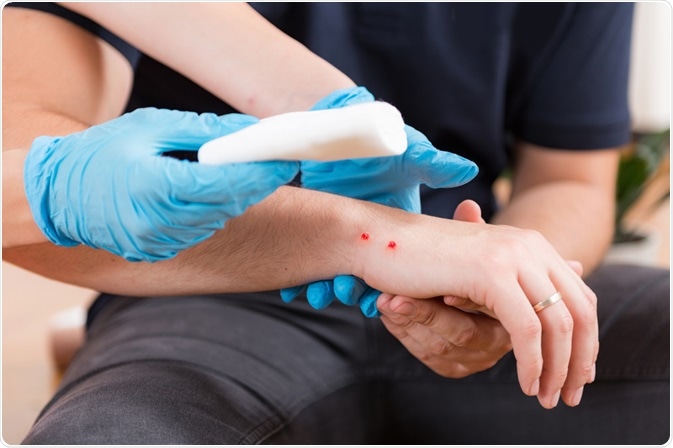A very common but globally neglected problem is envenoming following snakebite. Envenoming could be life-threatening and is caused by the toxins in the bite of a venomous snake. It primarily affects poor agrarian communities in many regions of the world, such as Africa, Asia, Latin America, and Oceania.

Image Credit: Microgen/Shutterstock.com
According to some estimates, over 5 million people are bitten by snakes each year and a substantial number of them either die or are left with permanent sequelae. However, the magnitude of the problem could be far greater than the above hospital-based statistics, which might be underestimating the actual incidence of snakebite and associated mortality and disability.
Antivenoms and the treatment of snakebite
Antivenoms constitute the only validated treatment of snakebite. Immunoglobulins are purified from the serum or plasma of animals hyperimmunized with snake venom and this gives rise to antivenoms. Its poor availability in many parts of the world (e.g. sub-Saharan Africa and parts of Asia) is the main cause of morbidity and mortality associated with snakebites.
The World Health Organization (WHO) has realized the seriousness of the problem and has made the technological platforms for antivenom manufacture available. Extensive details, such as manufacturing guidelines and quality control, have been put out in the public domain.
Advancements in research and development have significantly improved our knowledge of the main determinants of the quality and safety of antivenom manufacture. Therefore, this makes snakebite envenoming a “tool-ready” disease. While this may sound encouraging, there is much work that remains to be done. The availability of safe and effective antivenoms, in many poor parts of the world, is abysmally poor.
Some steps to enhance snakebite treatment
Augmenting capacity
The first step in managing snakebite envenoming is educating people about the adverse consequences and training healthcare professionals, in the most affected countries. The WHO has played a crucial role in this regard by supporting the creation of training resources and the development of standard treatment guidelines for healthcare workers.
Widespread access to effective and safe antivenoms
The key aim of medical staff is to reduce mortality and morbidity associated with snakebite envenoming. To this end, access to affordable, safe, and effective antivenoms should be increased. This is absolutely crucial as, to date, antivenoms are the only validated treatment to mitigate or reverse the adverse effects of snakebite.
Develop tests and tools
The reporting of snakebite envenoming remains a problem in many poor regions of the world and enhanced diagnostic tools could ameliorate this problem. More reporting could aid in determining the optimal antivenom needs for specific regions. Additionally, the development of point-of-care tools could aid in increased surveillance of snakebite envenoming.
Raise awareness
Snake bites may result in a variety of disabilities; such as substantial loss of limb use or even amputation. Sometimes, this may result in victims becoming engulfed in poverty or being socially ostracized. Raising awareness and improving access and equity of victims should be matters of utmost priority.
Antivenoms for international use
Some countries, such as Australia, Brazil, Costa Rica, Egypt, France, India, and Mexico, have large and well-established antivenom manufacturers and often the capacity could be sufficient to cater to the needs of other regions as well.
However, this requires the use of good quality venom pools from regions where the antivenoms are to be used. Extensive collaboration across research groups and manufacturers is required to design effective immunizing venom mixtures. The collaboration aspect was a key feature of a proposal put forward by the Global Snakebite Initiative to generate pan-African and pan-Asian antivenoms.
Antivenom potency, formulation, and presentation are technical aspects that should be modified depending on the country of usage. A key region of concern in sub-Saharan Africa and international initiatives are being encouraged to develop antivenoms for this region.
Collaborative research projects have resulted in the development of polyspecific antivenoms for sub-Saharan Africa by scientists in Mexico and Brazil and by manufacturers in France and South Africa. Elsewhere, researchers in Australia and Papua New Guinea have collaborated to develop a monospecific antivenom for the treatment of snakebite by a highly venomous taipan snake in Papua New Guinea.
It is imperative to have more such initiatives and partnerships using strategies tailored to the requirements and technical capabilities of each country and region.
Small molecule therapeutics (SMTs) to treat snakebites
SMTs, which are naturally occurring or synthetic molecules, represent a potentially useful complementary therapy to antivenoms. They could be used in various ways to reduce morbidity and mortality caused by snake envenomation, such as oral or intravenous administration.
Posthospitalization administration of SMT is also possible and that might help in reducing the risks of rebound effects from certain venom components. The use of SMTs as a complement to antivenoms could reduce the required dosage of the latter and also diminish treatment costs.
SMTs could help overcome some of the limitations of antivenoms. There is a low probability that SMTs would lead to allergenicity or anaphylactic shocks, compared to serum-based therapies.
Additionally, antivenoms often contain active toxic components, and SMTs, when used in an adjunct manner, could target these harmful components. A prudent, organized, and multidisciplinary approach will be needed to determine the next steps in the development and deployment of SMTs to effectively treat and manage snakebites.
Sources:
- Improving treatment for snakebite patients. (2019) The World Health Organization. [Online] Available at: www.who.int/.../improving-treatment-for-snakebite-patients#tab=tab_1
- Tommaso, C. et al. (2018) Developing Small Molecule Therapeutics for the Initial and Adjunctive Treatment of Snakebite. Journal of Tropical Medicine. 4320175. pp.10. https://doi.org/10.1155/2018/4320175
- Gutiérrez, J. M. et al. (2014) A multicomponent strategy to improve the availability of antivenom for treating snakebite envenoming. Bulletin of the World Health Organization. 92(7), pp. 526–532. https://doi.org/10.2471/BLT.13.132431
Further Reading